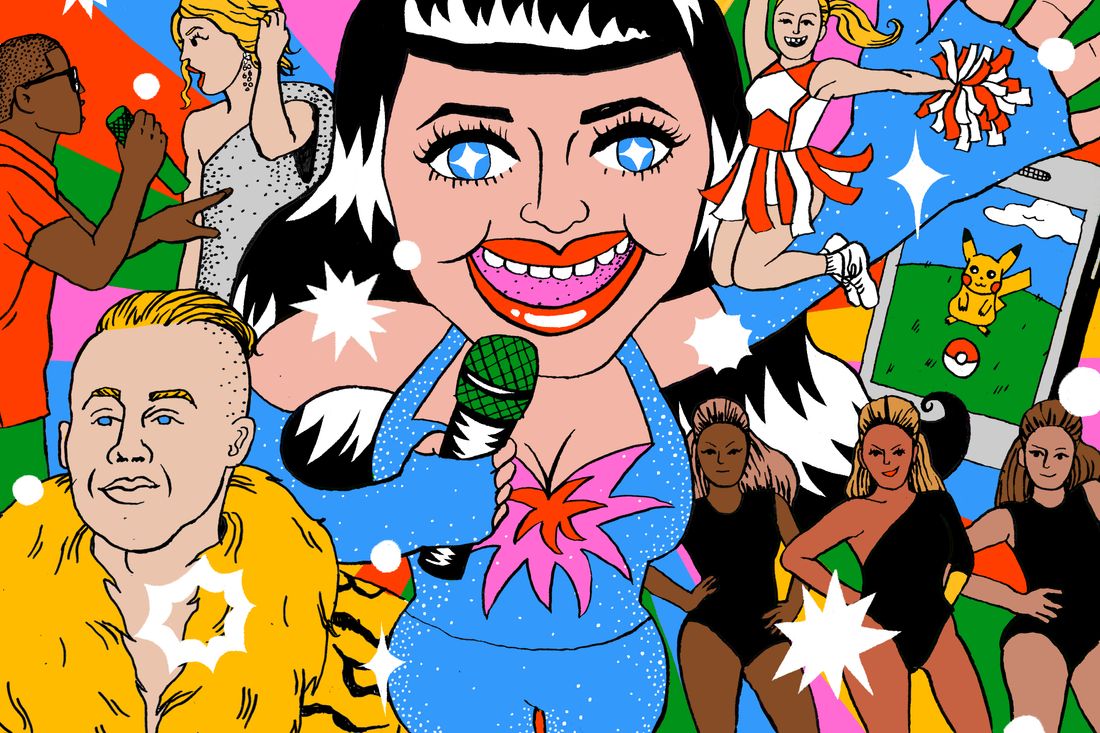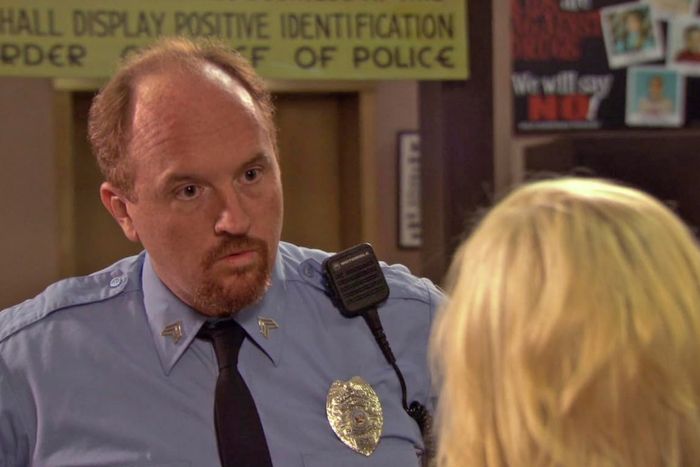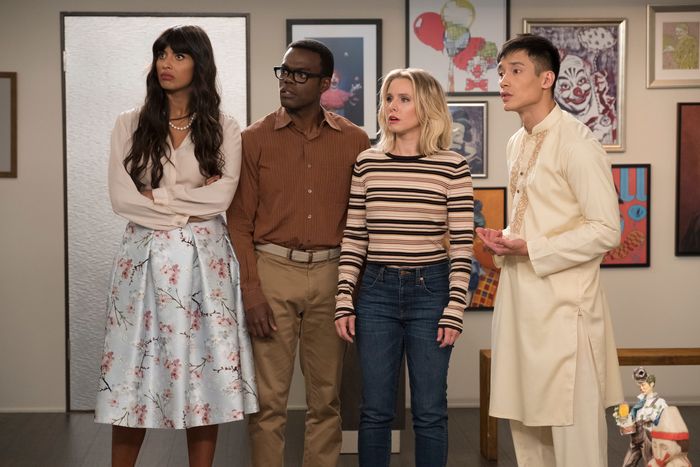
This article was featured in One Great Story, New York’s reading recommendation newsletter. Sign up here to get it nightly.
For the past month, much of American political life has resembled a game of Ouija. Democrats and those who vote for them are amusing themselves with the fantasy that they’ve been visited by some long-dormant spirit, even if the force they are imagining is just the movement of their own hands. The message sent from the great beyond spells Y-E-S-W-E-C-A-N.
Collectively, we are conjuring the ghost of the Obama era — that earnest, optimistic, energized, celeb-obsessed, self-conscious, cringeworthy time. It was an age that seemed dead and buried as recently as mid-July, when Katy Perry’s “Woman’s World” sought to revive the sound of the mid-2010s then promptly flopped. Two days later, Donald Trump survived an assassination attempt and appeared, for the moment, an indestructible electoral force, barely challenged by the sclerotic octogenarian in the White House. The nation seemed to be sleepwalking toward autocracy until the sudden ascent of presidential hopeful Kamala Harris changed everything. She has, as running mate Tim Walz crowed, brought back “the joy.” Within hours of Harris taking over the Democratic ticket, Fire Island twunks posed in matching Kamala crop tops. CNN panelists debated the question of whether Kamala was brat. Barbie-themed “Madame President” signs sprouted on lawns. Megan Thee Stallion twerked at a rally. Cynthia Nixon sipped from a coconut. A campaign has been constructed around a mood, rather than the other way around.
The mood is Obamacore — the outburst of brightness and positivity that took over pop culture upon the election of our first Black president in 2008, and that continued until the wheels fell off eight years later. This was the age of Glee, Taylor Swift’s 1989, and Hamilton, seemingly disparate art born out of the same impulse: the feeling of a new dawn, a generational shift, a national redemption. “There was an excitement to trust new things, the belief that new things were potentially good,” says Liz Meriwether, creator of the “adorkable” Fox sitcom New Girl that ran across both of Obama’s terms. In a departure from the sleaze and snark of George Bush’s aughts, Obamacore positioned itself as sensitive, non-threatening, and relatable. It was Aziz Ansari writing a book on modern dating alongside a Berkeley-trained sociologist, porn star James Deen talking about bacon, Louis C.K. playing a cop on Parks and Recreation.
In cultural history, this era remains a fascinating blip, a brief ray of hope sandwiched between the chaos and trauma of the Bush years and the bitter resistance of the Trump presidency. For wistful liberals, it was an age of doomed innocence waiting to be memorialized by some future Stefan Zweig. For others it was a decadent interregnum — Weimar with listicles. “The War on Terror expanded, the reactionary far right organized, the wealth gap grew,” trend forecaster Ayesha Siddiqi, who is currently working on a book about the aughts, recalled in 2022. “Meanwhile, my generation was dressing up as the kid from Where the Wild Things Are and reading Hipster Runoff to know how they should feel about Converse versus Vans.”
Cards on the table: The site you are reading played an active role in the creation of Obamacore. We lifted up the idols of the day and took sides in the feuds. It would be cowardly to disavow this work and pointless to defend it. If the idea of a deep dive into the pop-culture Zeitgeist of Obama’s presidency feels like an exhausting amount of navel-gazing, well, nothing could be more true to the spirit of the time.
“I’m paraphrasing Reagan, but there was a ‘Morning in America’ feeling when Obama was elected,” says Courtney A. Kemp, who would soon begin working as a writer on CBS’s The Good Wife. “I think about the ‘Hope’ poster, which my own child was named after. We really did believe in that stuff.” After Obama’s victory, she had a thought: “If you were a Black man in America and you’d been taught that there would never be a Black president — that was shattered. Your self-narrative about what you could achieve, all of that was potentially wrong.” This realization, she says, led directly to Power, the Starz crime drama about a drug dealer turned law-abiding business owner, which Kemp created in 2014 alongside 50 Cent and has since spawned four spinoffs.
It took years for Power to hit TV screens, but it only took a few weeks for Beyoncé’s “Single Ladies” to become the anthem of the honeymoon period between Obama’s election and inauguration. Music was quickest to adapt to the new dawn, with the biggest song of summer 2009 declaring tonight was gonna be a good, good night. Subsequent hits from Obama’s first term iterated on this theme: “There’s a party in the U.S.A.,” “the dog days are over,” “it’s always a good time.” “It was sparkly,” says “Fight Song” singer-songwriter Rachel Platten of the prevailing sound. “A lot of big pop production: huge drums, huge synths, and powerful choruses.”
Accompanying this optimism was a sense of generational handover. Four years after an election marked by the umpteenth relitigation of the Vietnam War, Obama’s victory signified that the future belonged to those who, contra the old saying, didn’t need drugs to not remember the ’60s. The promotion of Conan O’Brien to the Tonight Show desk in September 2009 was a symbolic victory for Gen X; that the job was shortly thereafter handed back to Jay Leno was taken by Conan’s audience as something more serious than the usual late-night shuffle — an attempt by the boomer elite to claw back the status they’d lost. Having become a cause célèbre, O’Brien used his final monologue to deliver a rare moment of earnestness: “If you work hard, and you’re kind, amazing things will happen.”
For millennials stuck in the long tail of the Great Recession, these years often took the form of an extended adolescence. A new word was coined for the previously unremarkable idea of fulfilling basic life duties: adulting. Instruments like ukuleles and xylophones escaped elementary schools and invaded YouTube. “There were so many things in the early Obama era being like, ‘I’m a freaking mess,’” says Megan Amram, a writer on the era’s two sunniest sitcoms, Parks and Recreation and The Good Place. To be unvarnished was to be authentic, an assumption baked into the confessional comedy of Marc Maron, the music of tUnE-yArDs, and the nude scenes in Girls. The latter’s pilot included a scene where two young women had a conversation while one was on the toilet — a trope that soon became this era’s visual shorthand for unfiltered realism.
While certain sections of the internet remained an adult kindergarten, in others, student government was in session. “At the time, it felt like our institutions were worth believing in, because they’d surprised so many of us,” says Carri Twigg, a former special assistant to President Obama who has since co-founded a production company devoted to socially conscious stories. “The election demonstrated they were in fact capable of living up to their promise, of bringing in people whom the institution was not designed to support.” (She emphasized, “at the time.”)
Thus, after years of “speaking truth to power,” the culture suddenly found that power wasn’t all bad. The fandom that had sprung up around Obama’s presidential campaign expanded to embrace New York Times columnist Paul Krugman, justice Ruth Bader Ginsburg, and later, Hillary Clinton. For a moment, bodies as hidebound as the Supreme Court and the papacy looked as if they might be rehabbed into vehicles for social justice. In an even more improbable development, a sitting president was more likely to be a willing participant in a late-night bit than the target of one. “Now, I hear people being like, ‘He was pretty bad on immigration and committed his share of drone strikes,’” says comedian Aparna Nancherla, who wrote on Totally Biased With W. Kamau Bell and Late Night With Seth Meyers during this period. “But at the time, everyone was like, ‘We can’t sully this moment.’ He felt a little unimpeachable, pardon the pun.”
The artistic culmination of this belief was Hamilton, whose opening number was unveiled at the White House in 2009. The musical rewrote the nation’s foundational myth as a paean to multiculturalism and immigration through the tale of a rapping Founding Father who transcended his humble origins to write his name into the history books. The implication was unmistakable: 240 years of American progress had culminated in the Obama administration.
Expertise, too, was back in vogue. French economist Thomas Piketty briefly became a left-wing crush object. People found it endearing when Neil DeGrasse Tyson nitpicked the science of Hollywood blockbusters. As our nation’s deepest thinkers sought to prove they had a sense of humor, so did comedy find itself invested with newfound importance. “Comedy started being treated as prestigious, which meant the writers were smart people thinking deep things,” says Amram. “There was this feeling that as a comedian, you had a responsibility to educate.” In the Parks and Rec writers’ room, she recalls a responsibility to “say intelligent things and make people feel good,” and also “a responsibility for gender and racial harmony.”
In this vein, a number of acclaimed comedies from this period were morality plays exploring the proper ethics of 21st-century society. Most influential of all was FX’s Louie, which between 2014 and 2016 was followed by BoJack Horseman, Master of None, and eventually The Good Place, making the subtext text. A better world was possible if art simply presented its audience with a model for how to live, the thinking went. Inherent in this idea was a certain unavoidable didacticism, which Nancherla sees as a response to the rise of the antihero a decade earlier: “A comedian’s brain naturally would be like, This person does a lot of fucked-up stuff … But would they ever think, Maybe I should stop doing fucked-up stuff?”
If there was a newfound sense of possibility around the types of stories worth telling in Obama’s second term, comedian and Daily Show alum Larry Wilmore didn’t see it diminishing the industry’s barrier to entry yet. “It wasn’t easy” to get shows like ABC’s Black-ish and HBO’s Insecure on the air, says Wilmore, who co-created each alongside Kenya Barris and Issa Rae, respectively. “At the time, it seemed like we had no shot.” When they began casting the Black-ish pilot in 2014, Wilmore says he and Barris felt uncomfortably lucky in the level of talent they had access to. “We were like, If this was a white pilot, all those white actors would be getting offers from other shows.” For Black actors, “it was a barren landscape. Six years into Obama, and we weren’t sure if we had a shot.”
The following year, Wilmore started hosting The Nightly Show With Larry Wilmore on Comedy Central. The series premiere, which aired on MLK Day, featured Wilmore asking guest Cory Booker, “You look very nice in a suit. Do you ever feel like you’re just a hoodie away from being face down on the pavement?” “We were tackling race head on,” he says. “I remember getting pushback from people who were used to watching The Colbert Report, where it was just a satire of the right. They weren’t quite ready for our racial show hitting you in the face.” Comedy Central canceled The Nightly Show in August 2016, 17 months after its premiere; by then, Wilmore would say later, he hadn’t heard from the network in months.
When Damon Wayans Jr., who co-starred in the New Girl pilot before jumping ship for another TV series, returned to Meriwether’s cast in season three, “we got questions being essentially like, ‘How can you have two Black actors on the same sitcom?’” she says. ( Lamorne Morris had been on the show for two seasons.) “That sort of ‘token person of color’ thing was so rampant. The idea that it’s not enough to just have a Black actor on your show, you need to have real Black representation throughout” wouldn’t make its way into boardrooms until the Trump era, she says. “It was still, ‘You can be a doctor, or the weird person who works at the 7-Eleven,’” Nancherla says. “It’s like, We have not made it.”
But slowly, television adapted, too. “It sounds a little Pollyannaish, but I do think that there was something to the time that made different voices a little more palatable,” says Kemp. “The word that everyone used all the time was underrepresented. People in the industry like metaphors, similes; they don’t always like to be so direct. But we could talk about feminism in a different way, which is absolutely what The Good Wife was about. We started to be able to talk about race in a more pointed way.”
At times, this led to groundbreaking art: the messy (mostly white) women of Inside Amy Schumer and Broad City; hit series from nonwhite creators like Scandal; prominent LGBTQ+ characters in series like Transparent and Orange Is the New Black. Just as often, the culture demonstrated a superficial, performative, or glib take on social issues — a white rapper’s Instagram apology for winning a Grammy, an all-female Ghostbusters remake, the idea that a Christmas song from the 1940s was secretly about rape.
This was also the golden age of the thinkpiece, personal essay, and BuzzFeed listicle, and in all of them, the notion of identity as authority held sway. The flipside of that idea was a rigid belief that, as J.P. Brammer wrote this year, “specific identities [conferred] a specific set of values, beliefs, and behaviors.” It became common to use demographic asides as moral shorthand: When Salon wrote in 2012 of “men (always men) who think comedy needs an ‘edge’ to be funny,” readers understood that meant the opinion was wrong. Predictably, this worldview spawned a pervasive racial ventriloquism. On the benign side, there were the Broad City girls imitating Rosie Perez’s Do the Right Thing dance; more malignantly, Rachel Dolezal; somewhere in the middle, Miley Cyrus at the 2013 VMAs.
When outspoken progressivism was both something to be celebrated and an undeniable social trend, how could you tell who was in it for the right reasons? The battle lines were often blurry. Were male feminists something to be proud of, or — as in the case of Nev Schulman’s 2014 elevator selfie — derided? When a white indie rocker said something tone-deaf about R. Kelly, whose side should you take? In the second term especially, these pop-culture controversies became a pressure-release valve for passions the political system could not accommodate and helped foment a destabilizing backlash.
By the final years of Obama’s presidency, the cracks were starting to show. For white liberals, this period brought self-awareness that frequently collapsed into obliviousness, as in the case of almost everything to do with Lena Dunham. On the left was a growing sense that the mainstream conversation about representation remained frustratingly surface level, handily satirized in the cartoon about female drone pilots. On the right, a reactionary tide was growing, fed by the backlash of 2014 — the year of Santa Barbara, Gamergate, and UVA.
In the White House, Twigg remembers the second-term administration taking a more “unabashed” approach to discussing race: “You could re-center some people and celebrate them in a way that wouldn’t threaten — at least that was the hope.” Now she wonders if the approach backfired. “I think we neglected to understand that white people did not feel celebrated. Listen, it’s one of those things where I have empathy, but not sympathy necessarily. But I think strategically it was a missed opportunity to be more thoughtful about how we could allow everyone to celebrate their identity.”
Obamacore hadn’t emerged from thin air. The most infantilizing elements of Obama-era youth culture were natural outgrowths of the childlike whimsy of aughts hipsterdom. The blog “Stuff White People Like” and Vampire Weekend’s debut album, each of which anticipated the coming decade’s infinitely recursive discourse around whiteness, both launched a full year before Obama took office. But unlike the gradual manner in which it began, the Obama era didn’t slowly fade away. When the cracks finally grew too big, November 2016 came as a sudden crash — as if those eight years had been a dream the country had been jerked awake from.
The first writers’ room for The Good Place assembled in early 2016, in what no one yet knew was the beginning of the end. “Obviously between seasons one and two, a very big thing happened that changed the trajectory of the show,” says Amram. Trump’s election caused a lot of soul-searching for a series about ethical resolve in the face of evil, but it also sparked her realization that in the first season, they’d been writing to “an imagined audience who all believed the same things as ourselves.”
Hope gave way to grief. In the Kübler-Ross model, SNL’s Kate McKinnon performing “Hallelujah” in character as Hillary Clinton was Denial. Channeling your feelings about the election into the Moonlight/La La Land Oscar race was Bargaining. No matter your thoughts on Obama’s legacy, it was clear the bill for those eight years was coming due. “I had an acquaintance say to me, ‘Now that Obama’s been elected, we’ll all have to pay for that someday,’” Kemp says.
Trump’s election was followed by eight years of Yellowstone spinoffs and the resurgence of Roseanne Barr. Isolated scandals around individual bad men like Woody Allen and Bill Cosby turned into the #MeToo movement, in which entire systems of power were revealed to be rotten. All your favorite male feminists were guilty of sexual misconduct. Kanye West became a Trump supporter. To zoomers too young to participate, the culture of the Obama years now appeared embarrassing — Lin-Manuel Miranda biting his own lip, forever. “Half of BuzzFeed’s content at the time was like, ‘This Republican Senator Doesn’t Hate his Gay Son,’” says Matt Stopera, the blogger who may have actually produced half of BuzzFeed’s content. “Gen Z would be like, ‘I can’t believe you were living in that world.’”
Rachel Platten had seen “Fight Song,” a single she’d written about her own battles, become synonymous with a political movement that was much bigger than her — and then that movement lost. “I felt a little misunderstood. I felt like, Wait, don’t make fun of me. I was just writing this to heal myself. Thank God my husband was like, ‘It is literally not personal.’” Still, she says, “I don’t think it’s naïve to be hopeful.”
This summer’s sudden reappearance of hope and positivity has spurred split reactions. Do you embrace your inner cringe, or try to tamp it down? (Platten is staying out of it: “I’ve done my part.”) The optimistic case is that, against all odds, we seem to have heeded the lessons of Obamacore. Generation Z is willingly climbing the coconut tree. The Harris campaign, with its “White Dudes for Kamala” fundraiser, seems to have successfully trialed a non-toxic model of identity politics for white people. But for those of us doomed to remember what the Obama years were like the first time around — the turbo-pop, the undercuts, the novelty Twitter accounts, the Internet Boyfriends, the girlbosses, the hashtags, the precise shades of pink — there is one last bracing thought. For better or worse, these were our ’60s, and we’re all just going to have to come to terms with that.





